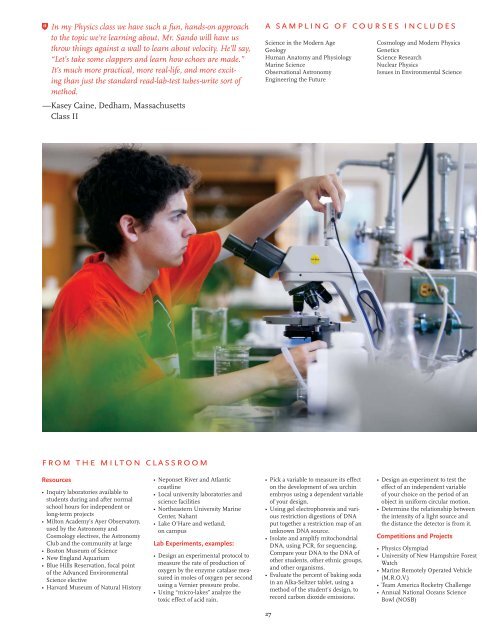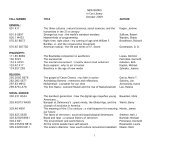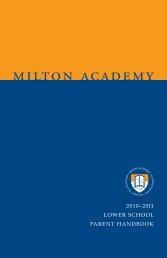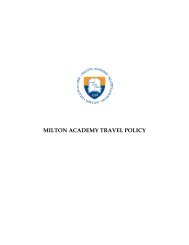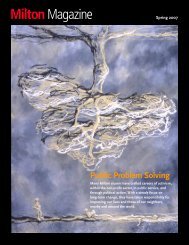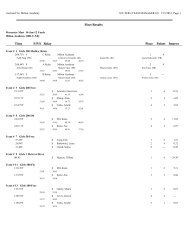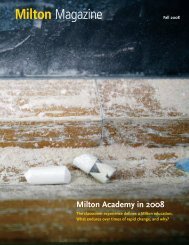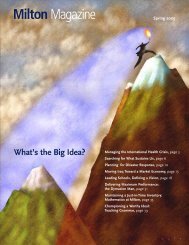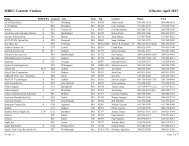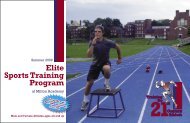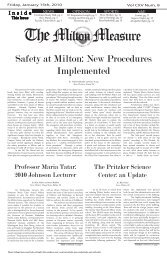sciencelearning by doingBy engaging students at all levels in doing science ratherthan just reading about it, <strong>Milton</strong> tries to build on the naturalexcitement of scientific exploration. We help studentsdevelop increasingly sophisticated skills in asking andanswering scientific questions.<strong>Milton</strong>’s course sequence beginswith physics, and moves tochemistry and then biology. Thephysics first curriculum relies onhierarchical learning and constructivism:that is, building students’understanding of scientificprinciples from the ground levelup. Experience with conceptualphysics enhances learning inchemistry, which in turn informsand supports understandingmolecular biology. For example,knowledge of the structure andreaction of the atom and anunderstanding of covalent andionic bonding is essential to learningabout biological moleculeslike proteins and DNA. Withouta grasp of the atom and bonding(from chemistry) learning aboutproteins becomes an exercisein memorization rather than inunderstanding.<strong>Milton</strong> offers honors andadvanced level courses as wellas deeply challenging electives.<strong>Milton</strong> <strong>Academy</strong> science is interactiveand creative, reinforcinginvestigation, imagination anddiscovery.independent milton scientistsEvery year, several <strong>Milton</strong> studentsfind their imaginations andintellects so fired they elect to doan independent study in science.Recently, four students—WileyCaine, Katherine Evans, AmandaFaulkner, Hannah Gallo—completed independent projects.All four students can point toparticular moments when sciencetook hold of their thinking.Wiley’s inspiration startedat <strong>Milton</strong> in Tony Domizio’sMethods in Scientific Researchclass, which “really got me intoinquiry.” Coupled with his family’slong-time interest in environmentalmatters, Wiley’s inquiryled to research on environmentallysound buildings. Amanda’scuriosity about fish farming grewstraight out of her experiencein California as <strong>Milton</strong>’s S.E.A.Scholar (an opportunity providedby the Roger Hallowell ’28Memorial Fund). She found thestudy of marine life so fascinatingthat she changed her <strong>Milton</strong>course schedule to include anindependent project on fish farming.For Hannah, the momentwas her research on sustainableforestry at the Maine CoastSemester. She made over 80phone calls and conducted morethan 20 face-to-face interviewsas part of her research. “Youbecame devoted to your topic.”Her presentation of her findingsto the rest of the School was “abig, pivotal moment. I had neverapplied myself that much; I hadnever known so much abouta topic before. It felt good.”Katherine has lived her whole life“across the street from water,” soshe has had a lifelong curiosityabout marine life. On any givenday, she says, “you can find mein hip waders mucking aroundin the marshes.” Two <strong>Milton</strong>experiences led to her project ofdissecting marine organisms:the dogfish dissection in MarineBiology and her participation inthe Blue Lobster Bowl marinescience competition at M.I.T.The only Class II student on the<strong>Milton</strong> team, Katherine found thecompetition eye-opening: “ThereI realized the extent of marine science.I wanted to learn more.”All four have felt the support ofthe <strong>Milton</strong> science faculty—facultyso excited about a student’sresearch that they stop by the labsand leave pertinent articles orbooks in that student’s mailbox.“It’s contagious,” says Katherine.“The faculty have such a personaladmiration for science that it’sinfectious. They’re so willing tohelp you foster your own passion.”Wiley concurs, “You learnthat science is collaborative.People get invested in what youare doing.”Nothing is certain in science;everything demands fresh,independent, and open-mindedscrutiny. “Teachers encourageyou to question, to discover foryourself,” says Katherine. “Test it.Figure out why it worked.” “I lovethe science department,” declaresHannah. DYO’s (the Do YourOwn research projects that are astaple of <strong>Milton</strong>’s science courses)significantly shaped Amanda’sway of thinking. “You had to figurethings out yourself. You werereally on your own. I liked that.”In Environmental Science, Wileylearned that environmental science,and by extension all science,“is global, not simple. You seemore and more connections asyou go on. You learn that nothingexists in isolation.”Each of these students engagedin a seminal <strong>Milton</strong> experiencebased in science. Wherever theircareers take them—and it’s tooearly to tell—their intense andearly connection with the scientificprocess will affect the sophisticationand skill they can apply todecoding their world.26
In my Physics class we have such a fun, hands-on approachto the topic we’re learning about. Mr. Sando will have usthrow things against a wall to learn about velocity. He’ll say,“Let’s take some clappers and learn how echoes are made.”It’s much more practical, more real-life, and more excitingthan just the standard read-lab-test tubes-write sort ofmethod.— Kasey Caine, Dedham, MassachusettsClass IIa sampling of courses includesScience in the Modern AgeGeologyHuman Anatomy and PhysiologyMarine ScienceObservational AstronomyEngineering the FutureCosmology and Modern PhysicsGeneticsScience ResearchNuclear PhysicsIssues in Environmental Sciencefrom the milton classroomResources• Inquiry laboratories available tostudents during and after normalschool hours for independent orlong-term projects• <strong>Milton</strong> <strong>Academy</strong>’s Ayer Observatory,used by the Astronomy andCosmology electives, the AstronomyClub and the community at large• Boston Museum of Science• New England Aquarium• Blue Hills Reservation, focal pointof the Advanced EnvironmentalScience elective• Harvard Museum of Natural History• Neponset River and Atlanticcoastline• Local university laboratories andscience facilities• Northeastern University MarineCenter, Nahant• Lake O’Hare and wetland,on campusLab Experiments, examples:• Design an experimental protocol tomeasure the rate of production ofoxygen by the enzyme catalase measuredin moles of oxygen per secondusing a Vernier pressure probe.• Using “micro-lakes” analyze thetoxic effect of acid rain.• Pick a variable to measure its effecton the development of sea urchinembryos using a dependent variableof your design.• Using gel electrophoresis and variousrestriction digestions of DNAput together a restriction map of anunknown DNA source.• Isolate and amplify mitochondrialDNA, using PCR, for sequencing.Compare your DNA to the DNA ofother students, other ethnic groups,and other organisms.• Evaluate the percent of baking sodain an Alka-Seltzer tablet, using amethod of the student’s design, torecord carbon dioxide emissions.• Design an experiment to test theeffect of an independent variableof your choice on the period of anobject in uniform circular motion.• Determine the relationship betweenthe intensity of a light source andthe distance the detector is from it.Competitions and Projects• Physics Olympiad• University of New Hampshire ForestWatch• Marine Remotely Operated Vehicle(M.R.O.V.)• Team America Rocketry Challenge• Annual National Oceans ScienceBowl (NOSB)27


